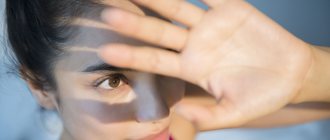In some cases, this condition is caused by the use of medications (for example, dilating the pupil), external factors, or diseases of the visual system. But, in any case, different degrees of this pathology are familiar to each of us, because we all feel photophobia when we leave a dark room into bright light. However, when a feeling of visual discomfort occurs for no apparent reason, it cannot be ignored. In this case, you should seek special help as soon as possible.
General information
Photophobia of the eyes, or otherwise photophobia, is a painful sensitivity of the organ of vision to light and refers to subjective visual disorders. Contact with even the slightest rays can cause quite unpleasant sensations in a person, including pain and discomfort in the eyes, spasm of the eyelids, severe lacrimation, resulting in an urgent need to squint the eyes.
The cause of photophobia usually lies in various eye diseases, but it can also be caused by measles , rubella , meningitis , encephalitis , epilepsy , pathologies of the cornea and conjunctiva, which could be caused by erosive processes and superficial inflammation. In addition, there is a possibility of developing photophobia when using eye drops to dilate the pupils.
The most famous people with photophobia were Hannelore Kohl, Lyubov Orlova, Anna Wintour.
What is Gunther's disease?
Gunther's disease is a fairly rare hereditary disease, during which disruptions in pigment metabolism and accumulation of porphyrin in the soft tissues begin. This substance has a nitrogen-containing pigment, included in hemoglobin, which gives blood cells the red tint familiar to people. The process begins development in the red bone marrow, interconnected with the action of red blood cell synthesis.
Pathogenesis
Hypersensitivity to any kind of light rays - natural or artificial - is usually a sign of disorders in the visual analyzer or nervous system - when the eye cannot perform its functions or the scheme of transmitting and processing information in the brain is disrupted. When a large amount of light hits the retina, neuroregulation must “give a command” that helps reduce contact with light so that the retina is not damaged, for example, narrow the pupil, close the eyelid, or an unconditioned reflex - involuntarily squint. If there are diseases or injuries to the organ of vision, the trigeminal nerve, or foreign bodies, then a “specific” negative reaction to light, even of normal intensity, may occur.
How to cure?
Currently, scientists have come to the conclusion that it is impossible to fully recover from this condition. However, it is possible to reduce the number of relapses. In addition, doctors in some cases use bone marrow transplantation. Doctors advise people suffering from Gunther's disease to spend a minimum amount of time in the sun. The following are used as braking:
- Nicotinic and ascorbic acid;
- Riboflavin;
- Cyanocobalamin.
What consequences can the disease lead to?
According to clinical data, such a disease can cause numerous metabolic problems in the patient’s body. All patients live for a short period of time.
Causes of photophobia of the eyes
The origin of photophobia can be of different nature:
- Physiological - photophobia resulting from prolonged exposure to darkness and twilight, too bright lighting, excessive UV irradiation, excessively long daily reading, working at a monitor or studying books; in addition, albinism and light eye colors as a result of translucent iris .
- Pathological - as a consequence of various burns, injuries, eye diseases, or is a symptom of chronic fatigue syndrome , dry eyes , depression , neurasthenia , headache , stroke , abscess and brain tumors , as well as intoxications , pityriasis rosea , rubella , , rabies , influenza , meningitis , epilepsy , manifestations of trigeminal neuralgia , blepharospasm , cataracts, glaucoma , Parkinson's syndrome , adenoviral or allergic conjunctivitis , keratoconus , retinal detachment and keratitis .
- Pharmacological - when using anticholinergic drugs that dilate the pupils, for example, Atropine , Ipratropium , Pirenzepine , as well as sedatives such as barbiturates, benzodiazepines, Haloperidol , the antiepileptic drug Ethosuximide , antidepressants, etc.
A number of factors and changes in the nervous system contribute to the development of excessive sensitivity to light. These include:
- increased sensitivity to loud sounds;
- depletion of nervous system mediators;
- lack of sleep;
- irritability;
- excessive emotional stress and stress;
- chronic fatigue;
- power errors.
Causes of photophobia in children
The state of hypersensitivity to the effects of light rays on the eyes may be transient and functional, or may be associated with other organic pathological processes. It is important to know what diseases photophobia can occur as a manifestation or complication of the disease and contact a pediatrician as soon as possible for their diagnosis and treatment!
How to detect?
The first symptoms indicating the presence of Gunther's disease begin to appear already in the first year of the baby's life. In special situations, they may occur several years later. The main symptoms of the presented process include:
- Scarlet color of urine, caused by a large amount of pigment in the body;
- Colored tooth enamel, which is evidence of the deposition of porphyrins on the teeth;
- Chronic photosensitivity is a process during which a burn may appear in the patient’s body due to the penetration of ultraviolet radiation through glass. Causes rashes;
- High level of hair on the epidermis;
- Significant growth of the liver and spleen;
- Destruction of red blood cells in the circulatory system.
Symptoms
The main symptoms of photophobia include:
- discomfort, pain, itching, sensation of a foreign body, veils and pain in the eyes, forcing you to squint, close your eyes, or there is a constant desire to wear sunglasses or curtain the windows;
- redness of the eyes;
- blurred eyes;
- increased intraocular pressure ;
- tearing and various types of discharge - mucous, purulent, etc.;
- nausea;
- dizziness;
- decreased visual acuity;
- negative emotional reactions and migraines when entering a space where there is bright sunlight, which promotes a closed lifestyle and forces one to avoid open spaces in the future, provoking agoraphobia ;
- increased discomfort in the eyes caused by other diseases.
Hypersensitivity to light rays can be accompanied by other mental disorders - depression, anxiety and other types of disorders .
Prevention
To prevent photophobia, follow these preventive measures:
- Selection of glasses or lenses by a specialist.
- Maintain visual hygiene: hydration, rest, removal of contaminants.
- Work at the computer or with documents intermittently.
- Sufficient lighting.
- Eye protection from ultraviolet radiation (glasses, wide-brimmed hats).
- Timely consultation with a doctor at the first alarming signs.
- Use of computer special glasses.
Photophobia is a symptom of many disorders. But this condition can be eliminated if the causes are identified in a timely manner, consult an ophthalmologist and follow his recommendations.
Photophobia in children
Most often, fear of light becomes an acquired disorder, but there are cases when it is congenital and is observed in children from an early age. For example, the reason for this may be albinism, color blindness, etc.
Photophobia in a child is a rather dangerous condition and can lead to the fact that it will be painful for him to look at the light, so parents need to ensure that their children have less stress, injuries, risk of infection, normalized use of electronic devices, optical instruments, compliance with hygiene standards, if necessary, correct vision correction, eye gymnastics.
Treatment
How to treat photophobia in adults and children? Since photophobia is only a manifestation of some kind of deviation, the underlying disease should be identified and eliminated.
Treatment for intolerance and fear of light may include the following:
- Drug therapy. Medicines are prescribed by a doctor after examination. Antibiotics or antivirals, analgesics and non-steroidal anti-inflammatory drugs (if the eyes are inflamed and painful), topical antibacterial or anti-inflammatory agents in the form of drops may be recommended.
- If fear and intolerance to light are caused by working at a computer, you must wear special computer glasses.
- Discontinuation of drugs that cause intolerance or side effects such as photosensitivity.
- Proper selection of contact lenses can also eliminate photophobia.
- Protecting your eyes from the sun will eliminate the manifestations of fear of light caused by exposure to ultraviolet radiation.
- If photophobia or high photosensitivity is caused by severe pathology or a congenital structural abnormality, surgical intervention may be required.
- Moisturizers (eg, artificial tears) for dry eye syndrome.
When negative factors are eliminated, photosensitivity disappears on its own within a few days or even hours. In other cases, the eyes may hurt and take longer to react to light.
Diet for photophobia (photophobia)
Diet for eyes, nutrition to improve vision
- Efficacy: therapeutic effect after 2 months
- Timing: constantly
- Cost of products: 1800-1900 rubles. in Week
Nutrition for vision problems should be balanced and capable of providing the body with proteins, fats, carbohydrates, fluids, vitamins and microelements. Approximately the diet should consist of:
- various vegetables, fruits and dried fruits, berries, juices, compotes and herbal teas;
- meat, eggs, fish and seafood;
- porridge and whole grain baked goods;
- In this case, food is prepared by boiling, baking, using a steam or multicooker, seasoned with high-quality natural oils, sauces, herbs, seeds and nuts.
Possible complications
The most dangerous complication of photophobia, in which a person lets the disease take its course or engages in the wrong method of self-medication, is loss of vision or its deterioration. Photophobia can also develop into heliophobia or fengophobia, in which a person loses the ability to lead a normal life.
Photophobia cannot be ignored; it can result in blindness.
Fear of bright light can be the beginning of a cold, viral or ophthalmological disease, timely treatment of which can also cure photophobia. It happens that a person treats the disease with disdain or does not turn to specialists, making attempts to recover on his own, which aggravates photophobia. However, it should be remembered that taking good care of yourself, particularly your eyesight, regular rest, and visiting an ophthalmologist will help get rid of photophobia and improve visual function in general.









